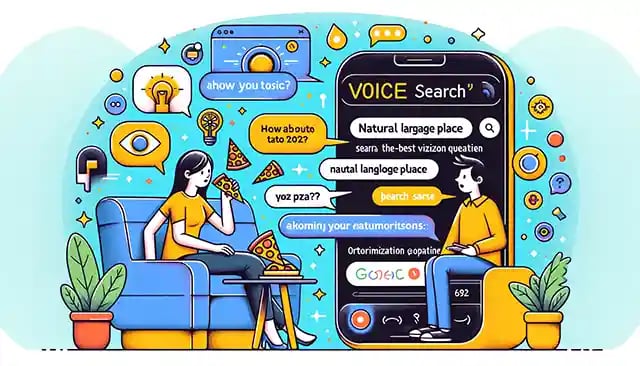SEO Trends 2024: Navigating the Latest Shifts for Growth
- Home
- SEO Trends 2024: Navigating the Latest Shifts for Growth
Picture a surfer riding the crest of a wave—this is what mastering SEO trends feels like in the digital ocean. Just when you thought you'd conquered the waves, another one appears with new obstacles and chances.
I've been that surfer for years, navigating through ever-changing algorithms and content marketing strategies to keep my content at the top. And let me tell ya, it's no leisurely paddle; it’s an adrenaline-pumping race against time and tide.SEO Trends
The landscape has transformed dramatically, from meta tags acting as gatekeepers to AI shaping our very approach to content creation. But here's your lifeline: In this piece, we're diving deep into how artificial intelligence isn't just complementing human ingenuity—it’s becoming a cornerstone of how Google understands relevance itself.
We'll also wade through the crucial roles of technical SEO, content quality and user experience because trust me—they can make or break your search ranking faster than a rip current.
Table Of Contents:
- Embracing AI in SEO: The Future is Now
- The Importance of Technical SEO and User Experience
- The Importance of Technical SEO and User Experience
- Google's Helpful Content Update and Its Implications
- Structured Data's Role in Enhancing Search Visibility
- SEO Industry Trends: The Rise of Voice Search Optimisation
- Long-Form SEO Content
- FAQs about Search Trends
- Conclusion

Embracing AI in SEO: The Future is Now
The digital landscape buzzes with the term 'AI', and if you're nodding along but not quite grasping its full impact on SEO, buckle up. AI isn't just a fad; it's reshaping how we optimize for search engines at warp speed. It’s like suddenly finding a turbo button on your car that you never knew existed – except this one optimizes content.
AI's Role in Content Generation and SEO
We’re living in an era where Google has become synonymous with knowledge itself. To keep up, SEO professionals are turning to AI-generated content as their new best friend. But let’s be clear, tossing keywords from a keyword tool into a robot writer won’t cut it anymore; it’s about creating value-packed words that resonate with both algorithms and humans alike. It's a long-term game.
In comes ChatGPT—think of it as the cool kid showing everyone else how to do homework right. By analyzing search intent more efficiently than ever before, these tools help create tailored experiences faster than saying "SEO trend". They give Google an understanding of what people want when they type out those burning questions in the search bar.
And here's some real talk from someone who breathes SEO: AI content doesn't mean kicking back while robots do all the work—it means getting savvy with data interpretation and using insights to craft stories only humans can tell.

How AI Tools Like ChatGPT Are Changing the Game
You know those times when something clicks so well it feels magical? That’s kind of what happens when advanced AI meets keen human strategy in SEO practices today—a little bit of magic ensues. With content optimization tools humming alongside creative minds, crafting spot-on messages for target audiences becomes second nature.
Leveraging deep learning models such as GPT-4 helps us identify long-tail question keywords without breaking a sweat (or overusing spreadsheets). And remember meta tags (meta titles, meta descriptions)? Well now imagine them supercharged by predictive analytics ensuring every tag works harder towards matching search queries and boosting click-through rates like stock market traders eyeing profitable trends—and yes, sometimes even outperforming them.

The Importance of Technical SEO and User Experience
Imagine you've arranged a special evening for your date. You want to impress, so you choose a fancy restaurant. But when your date arrives, the door's stuck. That's like technical SEO; it can make or break that critical first impression your website makes on Google.
Core Web Vitals as a Ranking Factor
If search engines were judges at a dog show, Core Web Vitals would be their scoring card for poise and performance. They measure how quickly content loads (Largest Contentful Paint), how soon it becomes interactive (First Input Delay), and how stable the layout is while loading (Cumulative Layout Shift). Google has made it clear: if your site struts with agility, expect better search demand and improved results.
Your users are VIP guests—they don't tolerate slow service or spilt drinks. Slow-loading pages? They'll bail faster than teens at an uncool party—hello high bounce rates. And just like party gossip spreads fast, bad user experience travels even quicker across social media channels affecting not just one visitor but potentially thousands more.
Enhancing User Behavior Metrics for Better Engagement
To turn browsers into buyers—or readers into subscribers—you need to charm them from hello to goodbye: enter organic CTRs and bounce rates. A stellar click-through rate signals relevance; it whispers sweet nothings to search engines about matching searcher intent perfectly. But beware of heartbreakers—the ones who leave without saying goodbye—a.k.a., visitors contributing to high bounce rates due to poor user experiences or irrelevant content.
User behaviour metrics aren't just numbers; they narrate tales of engagement love stories or tragic bounces gone too soon because let’s face it: nobody likes being stood up by webpages that promised much but delivered little.
And what do we know about Google? It loves match-making quality content with its rightful audience using search keywords and ranking factors grounded in user satisfaction—and nothing says 'I'm satisfied' quite like lingering longer on-page exploring every clickable corner as if there's hidden treasure beneath each pixel.
Think of your website like a first date; a structured topic layer, technical SEO and user experience set the stage. Just as a jammed door can ruin a restaurant's ambience, poor site performance can turn Google away before it even sees what you've got.
Google judges websites on their speed and stability with Core Web Vitals—quick load times, interactive pages, and stable layouts win top ranks. Bad experiences spread fast online, so keep users happy to avoid being the talk of the virtual town for all the wrong reasons.
To captivate visitors from start to finish, aim for high organic CTRs and low bounce rates. These metrics tell tales of engagement or lost opportunities—because no one enjoys web pages that fail to deliver on their promises.

Google's Helpful Content Update and Its Implications
Imagine walking into a store where everything is tailored just for you. That's what Google aims to do with its helpful content update—a big win for anyone tired of sifting through fluff to find answers.
Site-Wide Signals for Content Evaluation
The days when keyword-stuffed pages could climb the search ranks are long gone, my friend. Now, it’s all about whether your website can be the Mr. Rogers of your niche—trusted, reliable, and super helpful. Google now sizes up your entire site like a seasoned tailor measuring a suit; it wants to see if each stitch contributes something valuable or if there are loose threads that need trimming.
We're talking about those sneaky little signals spread across every nook and cranny of your site that tell Google one crucial thing: "Hey. This place knows its stuff." It might sound like finding a needle in a haystack at times, but once you get it right, boy does it pay off.
If you’re wondering how exactly these site-wide signals work, think back to when you last cleaned out your closet—if something didn’t spark joy or serve multiple purposes (looking at you, reversible belt), out it went. Similarly, this algorithm change encourages us to declutter our sites from low-quality content that doesn't quite fit anymore.
Creating Content That Ranks Higher Post-Update
Do you want your content not only to show up on the first page but also stay there like an unshakeable tree rooted deep within soil rich in quality and relevance? Well then buckle up because we're going full-throttle into crafting stellar SEO-friendly material post-Google update style.
To rank higher post-update means putting on Sherlock Holmes' hat—it requires detective-level attention to detail so as not to miss any clues (or keywords) that lead readers straight toward what they seek without detours around unnecessary filler town.
- Fulfil Your Reader's Quest: The magic happens when someone types their question into the search bar—and poof. Your article appears as though summoned by wizardry itself because you've anticipated their query with precision-crafted responses filled with context-rich information peppered throughout thoughtful paragraphs rather than relying solely upon short-form responses which may lack depth.
- Become Their Go-To Expert: When people trust in the authority radiating from each word penned down by writers who’ve walked miles wearing their audience's shoes, they're more likely to turn to these experts first for advice and solutions.
Google's helpful content update is changing the game. Sites now need to be like that one friend who always has your back—super reliable and packed with useful info. To win this, scrub out all the fluff from your site and pack it with top-notch content that answers questions like a pro.
Your articles should feel like they've read minds, showing up right when needed because you nailed what people are searching for. Become their trusted source by really getting what they're going through and serving up advice that hits home.

Structured Data's Role in Enhancing Search Visibility
At the party, you receive a business card that succinctly and effectively conveys who they are and what they do—much like structured data does for your website when it communicates with search engines. It's sleek, with just the right amount of detail to tell you who they are and what they do—no fluff, no clutter. That’s structured data for your website; it communicates directly with search engines, giving them the lowdown on your content so they can flaunt it in style.
Implementing Structured Data for Rich Snippets
To kick things off, let’s talk about how structured data hooks up with rich snippets to jazz up your presence in search results. Think of rich snippets as that extra sprinkle of glitter on your web page's search result—it catches eyes and draws clicks like moths to a flame. How can we bring this sorcery to life? By wrapping our content in specific markup languages like Schema.org vocabularies—that's when Google takes notice.
Digging deeper into implementing structured data means getting friendly with JSON-LD or Microdata formats—they’re kind of like different dialects spoken by websites around the world. With these tools under our belt, we're ready to add all those juicy details: reviews stars twinkling below our product listings or an upcoming event date highlighted right there on Google’s front page.
The goal here is not just visibility but also relevance—letting algorithms know precisely what each piece of content represents helps us rank better for relevant searches. And remember those key stats we mentioned? They back this up big time. When done correctly, using structured data can significantly enhance click-through rates because users see exactly what they want before even clicking through—a sneak peek if you will.
Weaving SEO keywords into this narrative isn’t about shoehorning them awkwardly into sentences; it’s about understanding their role within the grander scheme: Structured data acts as signposts that guide search engines towards finding contextually relevant information easily—and that includes everything from meta tags which summarize pages down to long-tail question keywords begging answers only YOU might have.
Now imagine pulling out real-time insights straight from social media chatter or stock market trends—all possible thanks to metadata empowering richer analysis capabilities across various platforms including voice search where natural language reigns supreme (and yes I'm winking at AI-generated content).
Beyond simply optimizing title tags though lies another treasure trove often overlooked: authority signals sent via proper use of schema markups help solidify trust between site and searcher alike – after all don't forget people crave assurance more than anything else online nowadays especially considering challenges facing seo professionals every day trying stay ahead game changing faster than chameleon disco ball (yes that exists).
Think of structured data as your website's flashy business card for search engines—it's how you make content pop in search results with rich snippets. Use tools like JSON-LD to sprinkle magic on your listings, from review stars to event dates, and watch those click-through rates soar.

SEO Industry Trends: The Rise of Voice Search Optimisation
Imagine chatting with your friend about the best pizza places in town. You'd ask, "Hey, where can I get an awesome pepperoni slice?" Now picture asking Google the same thing through voice search. It's no surprise that more people are ditching their keyboards and talking to their devices like they're old pals. And here's why it matters: optimizing for natural language queries is not just smart; it’s becoming essential.
Optimizing for Natural Language Queries
Voice search has taken a seat at the big kids' table, thanks to its convenience and our love for multitasking. With smartphones being practically glued to our hands and smart speakers popping up in homes everywhere, speaking out a query feels as natural as breathing.
But let me spill some tea—search engines have been eavesdropping on these chatty habits. They've gotten pretty good at understanding us too. This shift means stuffing keywords into content like sardines won't cut it anymore because real talk trumps keyword density every time.
To ride this wave successfully, we gotta think like humans—not robots—and sprinkle those long-tail question keywords into content just right. Picture yourself baking SEO cookies; you need just enough question keywords so your audience smells them fresh from the oven but doesn't choke on them.
Natural language processing (NLP), anyone? That's what helps Google pick up what you're putting down when you use conversational speech in voice searches—it gets context better than ever before.
This tech evolution calls for crafting meta tags and descriptions that sound less like robotic commands and more like something off a coffee shop menu—enticing yet straightforward:
- "Find out how these skin-care products will make your mornings brighter."
- "Why settle for good hair days when you could have great ones?"
- "Escape reality with fantasy novels that transport you to other worlds."
Aiming For The Snippet Spot
Do you know those nifty boxes that show up above all other results sometimes? Yeah—the featured snippets—they’re gold mines. But landing there isn’t about luck; it’s about the precision engineering of answers tailored specifically for spoken questions. Take phrases starting with "how," "what," or "the best way to"—they tend to trigger these snippet opportunities if matched well with users’ curiosity piqued by voiced doubts or dilemmas. Plus, structuring data properly can be quite handy here since rich snippets want nothing more than sweetly formatted info. So, give them what they crave: clear, concise responses organized in a user-friendly manner that even search engines can't resist.
As voice search becomes the norm, ditch keyword stuffing and optimize for natural speech. Think like your audience talks; use long-tail question keywords just right. Make meta tags sound human—enticing, clear, real. Aim to answer those "how," "what," or "best way to" questions well enough to hit that featured snippet gold mine.

Long-Form SEO Content
Gone are the days when a quick 500-word piece would win the SEO race. Today, it's all about long-form content that digs deep into topics, providing thorough insights and keeping readers hooked from start to finish. But why exactly is this type of content taking centre stage? Let’s break down how meatier posts can boost your online presence and authority.
The Value of In-Depth Analysis for Your Target Audience
First things first: People crave comprehensive answers to their burning questions—Google knows this well. The search engine rewards blog posts that serve up in-depth analysis because they deliver what users need: solid information backed by research or personal experience.
Your target audience doesn't just want surface-level info; they're looking for articles so informative they feel like mini-books on their favourite topics. Long-form pieces show you've done your homework—and then some—which helps establish trust with your readers (and Google).
Social Media Shares Love Substance Over Fluff
We’ve seen time and again that insightful long-reads get more shares on social media platforms compared to short snippets. This isn’t rocket science; it’s simple human behaviour. When people find value in something, they want others to benefit too—that’s why detailed guides often go viral across LinkedIn feeds or Twitter threads.
If somebody takes the time to read through your lengthy writing, they may hit 'share' if it resonates with them or makes them appear smart in front of others.
Leveraging Video Content Within Textual Narratives
Incorporating video content within your sprawling text not only breaks up those walls-of-text moments but also caters to visual learners who might be part of your audience mix. Plus, videos keep folks on-page longer—a key metric known as dwell time which signals search engines about the quality of content residing on your site.
A pro tip here: Don't shove any random clip into an article willy-nilly. Make sure each video enhances the narrative or explains complex concepts visually—an infographic come-to-life style approach works wonders for engagement rates.
Making Every Word Count With Quality Content Optimization Tools
You know what doesn’t fly? Rambling just for length's sake—it has got to be top-notch from headline through conclusion. That means no fluff-filled paragraphs where readers zone out faster than teenagers during family dinners...
Long-form content rules the SEO game, offering rich insights and earning trust from readers and Google alike. It's not just about length; it's value-packed, research-backed info that wins shares on social media and boosts your authority.
Incorporate videos smartly within long articles to keep users engaged longer while improving dwell time signals for search engines—just make sure they add real meat to your story.
Remember: Quality beats quantity every time. So use tools to optimize your work ensuring each word holds its weight in gold—no rambling allowed.
FAQs about Search Trends
What are the current SEO trends?
Right now, it's all about AI in web content creation, a laser focus on user experience, and ensuring your content is ultra-valuable post-Google updates.
What is the new SEO in 2024?
In 2024, fine-tuning for voice search and optimizing with rich snippets from structured data take centre stage.
What are the SEO trends for 2024?
SEO remains vital. We're eyeing predictive analytics and more sophisticated personalization to steer SEO's future direction as we edge into 2024.
What three trends might show up in SEO analysis?
Dig deeper into video optimization, hyper-localized content targeting, and mobile-first indexing as these big hitters gain traction.
Conclusion
Surfing the SEO trends of 2023, you've learned that AI is your ally. Let it sharpen your content and boost your Google rank.
Dive into technical SEO and user experience to gain valuable insights. They're not just important; they're crucial for staying afloat in Google's ocean.
Remember, post-update, create with care. Content isn't king unless it's genuinely helpful—and that’s what ranks today.
Structure data like building sandcastles: precisely so your content can catch the eyes like seashells on shorelines.
Speak as people do when optimizing for voice searches—casual, clear, natural—because this wave is only getting bigger.
The takeaway? Stay agile. Adapt fast to these shifts because mastering them means riding high on the digital swell for longer than ever before.

